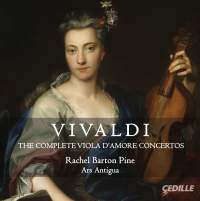Texte paru dans: / Appeared in: |
|
|
Outil de traduction ~ (Très approximatif) |
|
|
Reviewer: Raymond
Tuttle I can safely say that it has been almost eight years since I heard most of these works, since it was in early 2008 (Fanfare 31:5) that I reviewed a CD of Vivaldi’s complete viola d’amore concertos as played and conducted by Fabio Biondi (Virgin 95146). I liked that disc, by the way, and I liked the music, not feeling that it was “too much of a good thing,” although it is highly unlikely that Vivaldi himself would have sat through these concertos without taking a biscotti break. It is helpful that one of these concertos—the last on both discs, actually—adds a lute to the mix, and that RV 97 is given a more varied and festive sound by the addition of wind instruments. (On Biondi’s disc, replace “festive” with “seriocomic.”) Rachel Barton Pine, usually known (like Biondi) as a violinist, did not even lay her hands on a viola d’amore until 2007, the year before Biondi’s recording. That was a loaner, and since then she acquired the instrument made in 1774 by Nicola Gagliano which she plays on this CD. (Interestingly, the violin that she plays on her Baroque recordings was not only also made by Gagliano, but it also was made from the same tree.) This is a 12-string instrument—six of them are resonating strings which are not directly played by the performer. This gives the instrument its unusual and, to many, very attractive sound—a sort of sonic penumbra. Leopold Mozart remarked that “it is a special kind of violin that sounds especially beautiful in the stillness of the night.” It fell out of fashion as the 18th century drew on, but it never completely disappeared, and a few modern composers still are writing for it. Bernard Herrmann used it to represent Mary (Ida Lupino), the sensitive, blind protagonist in Nicholas Ray’s 1951 thriller On Dangerous Ground. Chicago-based Ars Antigua contains a few more strings than Biondi’s Europa Galante ensemble, and the sound on this CD is consequently fuller, but not much. That is because Virgin’s engineers have miked Europa Galante more closely than Cedille’s did Ars Antigua. There’s an intimate, chamber music-like quality to Biondi’s disc that is not present on Pine’s, but Pine’s sounds more like what you would hear in a small concert hall. Both recordings eschew the violently driven style of Vivaldi performance that we occasionally are given under the guise of authenticity. Indeed, the difference in timing between the two discs, with identical repertoire, is under two minutes, which is hardly noticeable in a program of this length. When she is playing with the other musicians, Pine is more integrated into the ensemble than Biondi, although there is no lack of assertiveness when Vivaldi puts the spotlight on the soloist. Also, Pine plays with more vibrato than Biondi. Overall, although both discs feature period performance style on period instruments, this is emphasized on the Virgin release more than it is on the Cedille release.
If I were
forced to make a choice, with the proverbial gun to my head, I’d probably
choose Biondi, because I think he is a touch more expressive than Pine. This
new disc is more than satisfying, however, and Pine is an amazing
player—listen to her in the first movement of RV 397, for example—so I am
glad I do not have to make that choice. | |
|
|
|
|
Cliquez l'un ou l'autre
bouton pour découvrir bien d'autres critiques de CD |
|




